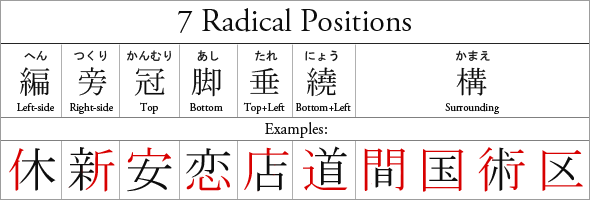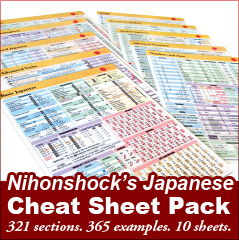Taking Kanji Apart: Radicals and Components
As any learner knows, kanji are an inescapable and daunting aspect of learning Japanese. There’s more than 2000 of the little devils and each one has multiple pronunciations, multiple meanings, and a predefined stroke order. That’s a lot to learn, so it’s understandable that most teachers and books avoid getting very deeply into the radical (
Indeed, learners will have no problem passing even the N1 level of the JLPT without knowing that 氵 is called さんずい or that 疒 is やまいだれ. However, in my personal experience communicating with native Japanese speakers as well as other Japanese learners, I’ve been thankful to know the names of some common radicals, and regretful that I couldn’t name more. Kanji radicals aren’t required for Japanese proficiency, but ignorance of them is a shortcoming nevertheless.
With that said, this article intends to explain the basics of kanji radicals (as well as their quirkiness), and also introduce to the reader a good beginning vocabulary on the subject.
Why radicals suck
If you’re an intermediate or advanced learner, you probably have a kanji dictionary of some kind. It probably organizes kanji by radicals, which are grouped by stroke count. And it probably has a section for kanji with no apparent radical. This is the most intuitive and effective way to get the job done.
Unfortunately, although the basic idea is the same, the real radical system used in Japan is far less intuitive than you might think. For one thing, there is no such thing as a kanji without a radical.
Even the lowly
In many cases it’s impossible to tell for certain what a kanji’s radical is just by looking at it. For example, most Japanese learners would start searching for
And 巛 leads me to my next gripe; single radicals have multiple forms.
Your kanji learner’s dictionary has probably also invented some radicals that (although logical and helpful) don’t actually exist! Those dots at the top of 営 and
Don’t despair!
Even native speakers–unless they’re actively studying kanji–don’t know radicals very well either. To get to their level you basically just need to have a general idea of how the system works including some of its quirks (like those explained above), and also remember terms for a few common radical forms.
So, let’s move on to some vocabulary! Actually, once you get the basics, most of the time you can come up with these terms on the spot. For example;
First, a quick note: while each kanji has only one
In this list, I tried to cover common but not obviously-named radicals. Here’s a link (Japanese) to a much more complete collection if you’re interested. The Japanese Wikipedia article on radicals is also packed with detailed info. The English Wikipedia article isn’t so shabby either.
Most radicals can be classified in one of seven types, depending on their position in the kanji.

Table: Basic Radical Vocabulary
This table gives the names of various components (in hiragana), and several example kanji for each. If I thought clarification was helpful or necessary, I added the kanji on which the component is based in parenthesis after the hiragana reading.
| :ぶしゅ - Radical (for classification) | ||
| :へん – Left-side component | ||
| さんずい |
にんべん ( |
|
| にすい ( |
ごんべん : |
|
| こざとへん (阜) : |
ぎょうにんべん : |
|
| けものへん ( |
がつへん : |
|
| ころもへん ( |
とりへん : |
|
| しめすへん ( |
りっしんべん ( |
|
| : つくり – Right-side component | ||
| りっとう ( |
ぼくづくり (攴) : |
|
| おおがい : |
ほこ/るまた : |
|
| おおざと (邑) : |
とます : |
|
| さんづくり : |
おのづくり : |
|
| ふるとり : |
また : |
|
| : かんむり – Top-side component | ||
| くさかんむり ( |
わかんむり (ワ) : 冗 |
|
| うかんむり (ウ) : |
あみがしら (网) : |
|
| たけかんむり ( |
なべぶた : |
|
| あながしら : |
はつがしら : |
|
| : あし – Bottom-side component | ||
| したごころ ( |
ひとあし : |
|
| れんが |
したみず : |
|
| : たれ – Top+left-side component | ||
| がんだれ : |
まだれ : |
|
| やまいだれ : |
とだれ : |
|
| : にょう – Bottom+left component | ||
| しんにょう (辵) : |
えんにょう : |
|
| そうにょう : |
||
| 構 | : かまえ – Enclosing component | |
| もんがまえ : |
ぎょうがまえ : |
|
| くにがまえ : |
つつみがまえ : |
|
A couple other quirks
There’s a couple radicals that appear identical, but are actually considered different. Look at the these two characters:
See that
So in
Next, look at these:
The radicals of these kanji are also written and look the same, but differ according to what kanji they are based on.
Finally, I want to mention the kanji
The bottom piece of








[…] a 31. kártyán kicsit sokkolt, függetlenül attól, hogy kevés vonásszámú, egyszerű gyökökből épül fel. Szóval ezt a kártyázós dolgot én inkább memorizálásra, ismétlésre […]